Below you will find the report that I wrote about my visit to the Moluccas in Jan/Feb 2017. Please feel free to spread the report in your network. Enjoy reading!
170227-visit-to-the-moluccas-waste-management-challenges-in-indonesia

Below you will find the report that I wrote about my visit to the Moluccas in Jan/Feb 2017. Please feel free to spread the report in your network. Enjoy reading!
170227-visit-to-the-moluccas-waste-management-challenges-in-indonesia
In May 2016 Waste Free Waters celebrated her 5th birthday. In these 5 years a lot of progress has been made. When we started, nothing was known about riverine litter and Waste Free Waters just took a pragmatic approach by just beginning. With the help of PlasticsEurope, Chemelot and my former employer Zuyd University we started to unveil the presence of litter in a river and we learned a lot about the way litter is transported . This story can be read in the earlier blogs.
Waste Free Waters is the most minimalistic foundation you can imagine. As a retired professional the costs for the activities of the Foundation are just travel expenses and the costs for some equipment like a computer and printer, maintenance for the camper and trailer and for networking and communication. No salary costs and only very limited overhead costs. But both projects, the new sampler and the mini Plastic-to-Waste installation, need funding and sponsoring.
To secure the activities of Waste Free Waters for the coming years, an amount of € 10.000 is needed to cover the overhead costs.
The development and construction of the new sampler will cost € 75.000 and the development, construction, testing and (Indonesian) introduction of the mini Plastic-to-Fuel installation will take around € 50.000.
Waste Free Waters is a recognized non-profit foundation with ANBI-status. You can contribute with any donation and you can use the following account number:
Waste Free Waters Foundation
account nr: NL64 ABNA 0554 1070 58
BIC code: ABNANL2A
and use the reference: “Donation”
or use this link:
Waste Free Waters is totally open to discuss our insights and experiences and to share it with anyone who deals with the problem of riverine litter. Transparency and open communication can only bring us all further in understanding the problem of riverine litter and will lead to solutions for this enormous worldwide problem.
For contact you have the following options:
email: g.tweehuysen@wastefreewaters.nl
phone: +31 (0) 653693382
Facebookpage Waste Free Waters Foundation:
https://www.facebook.com/Waste-Free-Waters-610036559016085/
Personal facebookpage Gijsbert Tweehuysen:
https://www.facebook.com/gijsbert.tweehuysen
It’s now februari 2015. It has been some time since my last contribution on this blog and a lot has happened.
First of all, I am (something like) retired. That means that I have no formal employer anymore. It took some time to adjust to that new status, but now I am settled in this situation and the possibilities and time to follow my “plastic waste” passion have only grown.
Secondly, the Foundation Waste Free Waters is formally established in August 2013 as an independent organization aimed at reducing river litter flowing into the sea. Our slogan is: Waste Free Waters: a Matter of Facts!
Thirdly, Waste Free Waters contributed to a very interesting and challenging European project to identify the amount of litter that is present in a number of European rivers and which is transported to the 4 European Seas: the Baltic Sea, the North Sea, the Mediterranean Sea and the Black Sea. This project took place during almost the entire year 2014 and in a later post I will tell more about the findings of this project. We learned a lot!
Finally, we now know how to measure river litter. The year 2015 will be a year to develop new methods to sample the riverine flow of litter in all sorts of conditions and to engage in projects on a European scale to mitigate this problem. The lessons learned from the “Schone Maas” project will be applied in new initiatives in the Netherlands and elsewhere in Europe.
I keep you posted!
PS: follow the Facebookpage of Waste Free Waters:
https://www.facebook.com/pages/Waste-Free-Waters/610036559016085
During 2012 we have done our first trawls with the set-up we have developed for measuring the amount of litter that is transported by the Meuse. At the time of the sampling, the conditions of the river were very calm and we did not expect to find very high numbers of items. But it turned out that the results were already very significant. After drying, counting and categorizing the caught items, the conclusion was that the amount of litter in the river was big enough to take the problem of river litter very serious.
We did find a substantial amount of macroplastics and we believe the method we developed is capable of delivering valuable data for assessing the contribution of rivers to the problem of plastic litter in the seas.
Until now, beach sampling was the only method available to assess the volume of litter in a river. Our data shows that a substantial part of litter, mainly the flexible fraction, remains in suspension and will not be found on an river bank, unless it is caught in the vegetation. The real amount of flexibles will probably be much higher than presented here in the slides. It takes some more hydrological analyses to determine the dispersion of these parts in the whole water column, here we have only used the number of flexibles that were present in the upper 70 cm.
It also turned out that a major part of the items are smaller than 25 mm. That does not include them in the category of microplastics (< 5 mm), but they could be small enough to be missed in sampling on a beach.
The presentation below describes the results of the initial trawls and a way of thinking to approach the problem of river litter, recovery and appropriate legislation as a whole.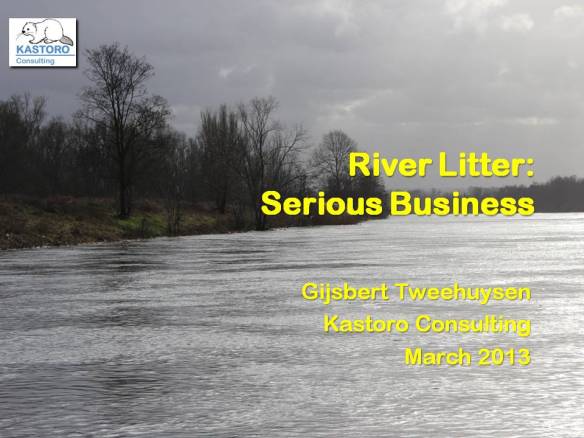
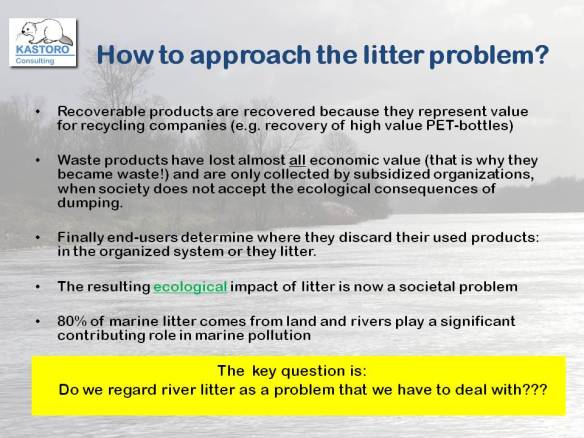
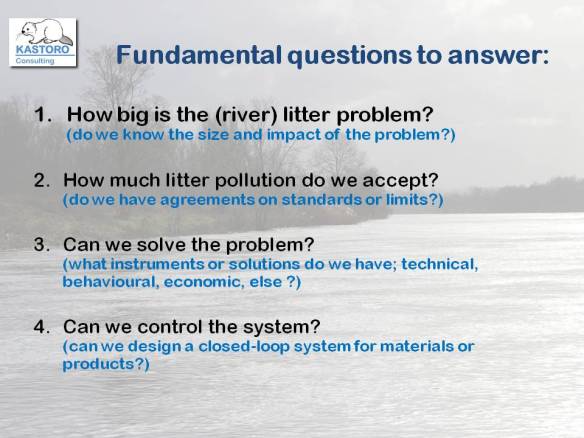
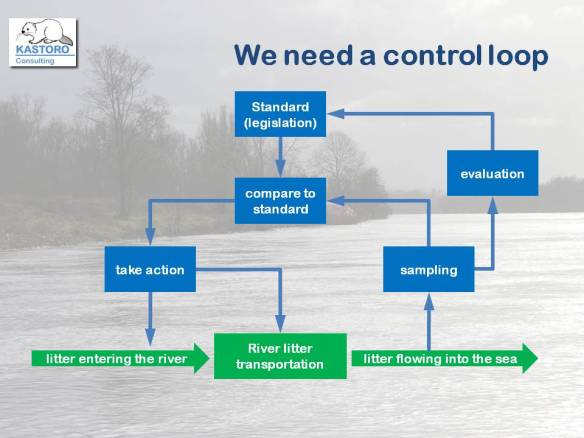
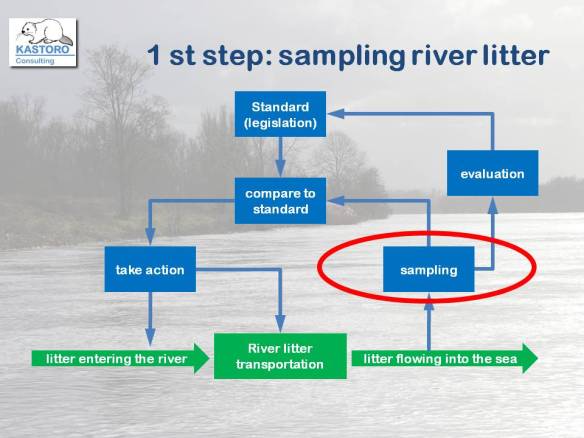
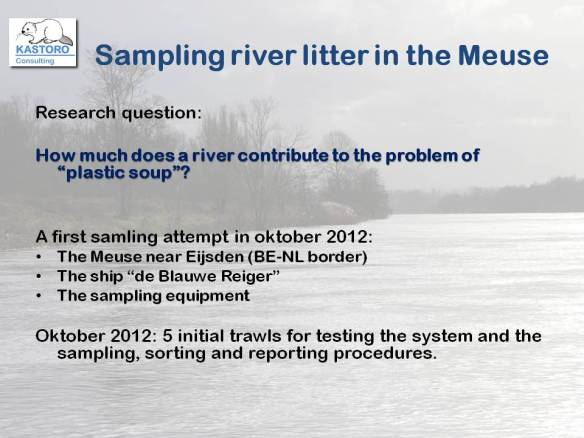
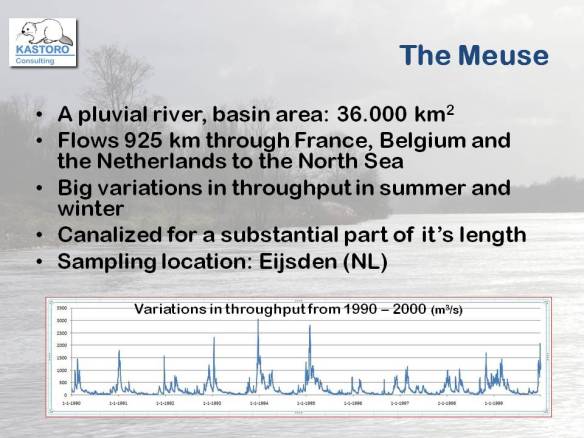
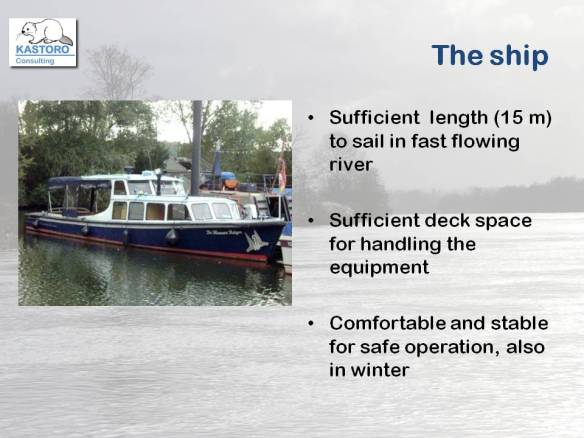
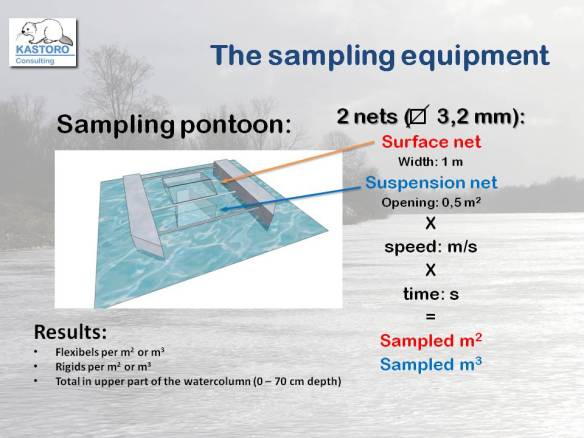
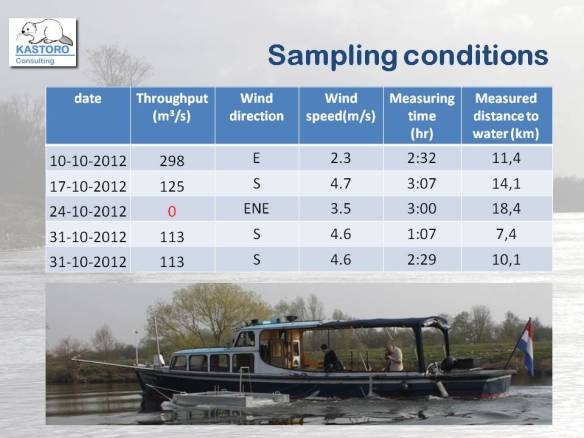
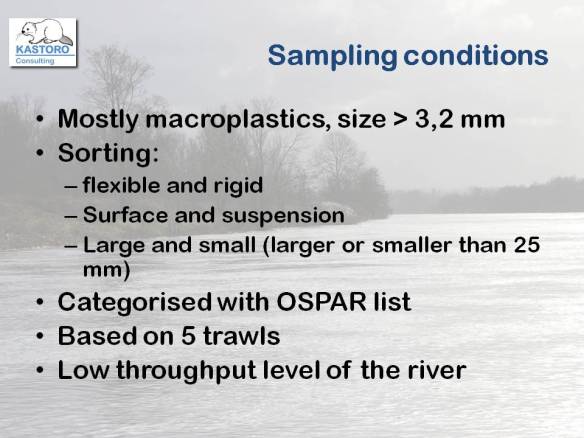
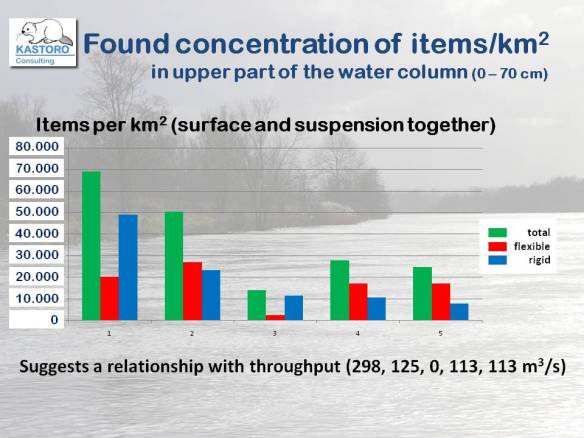
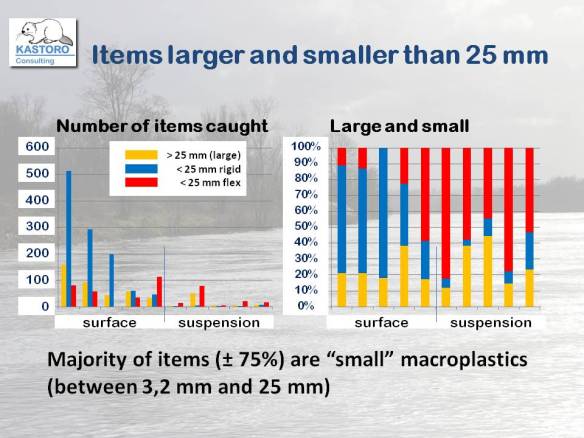
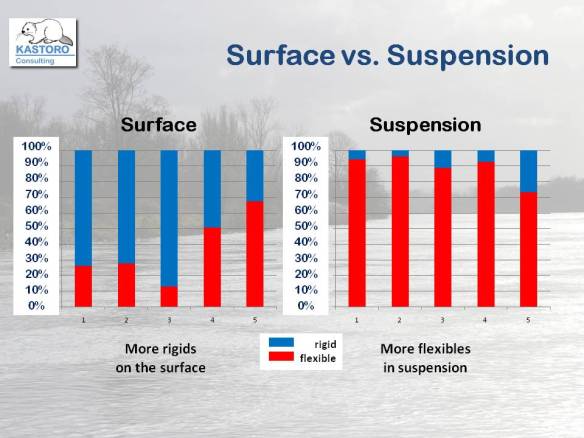
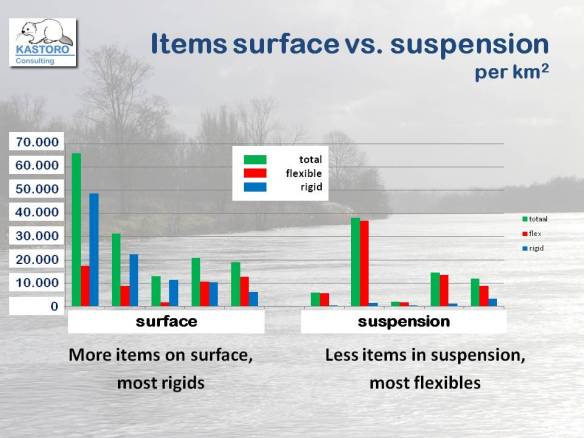
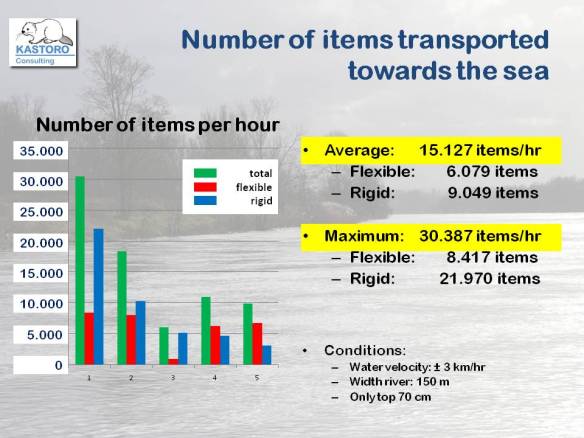
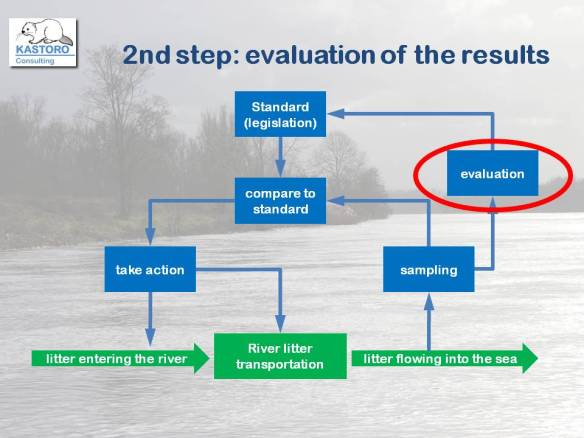
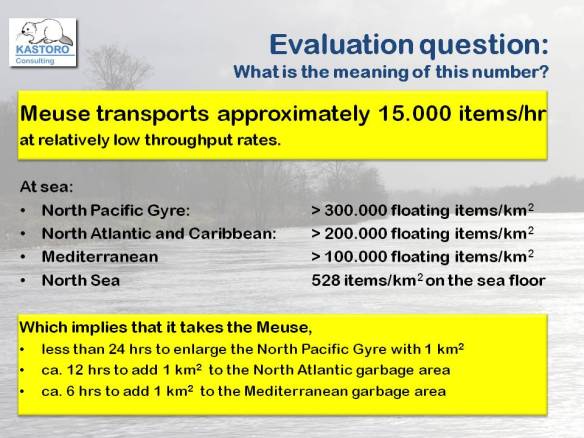
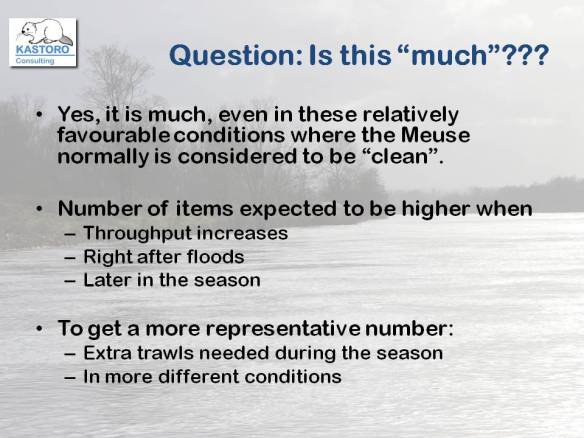
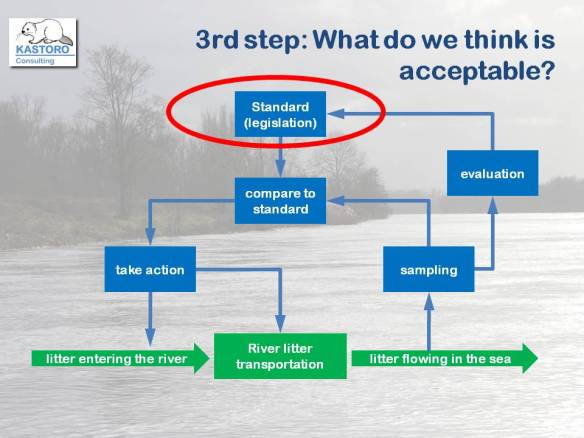
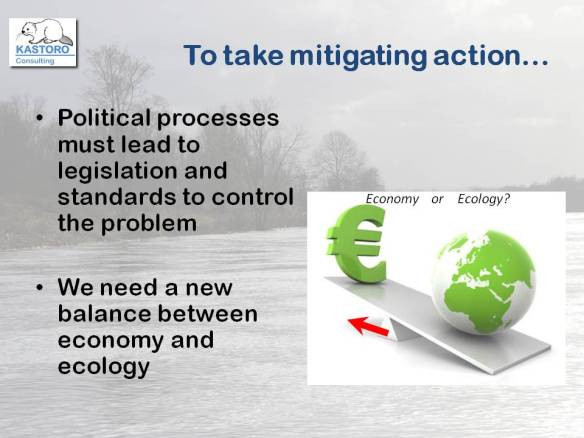
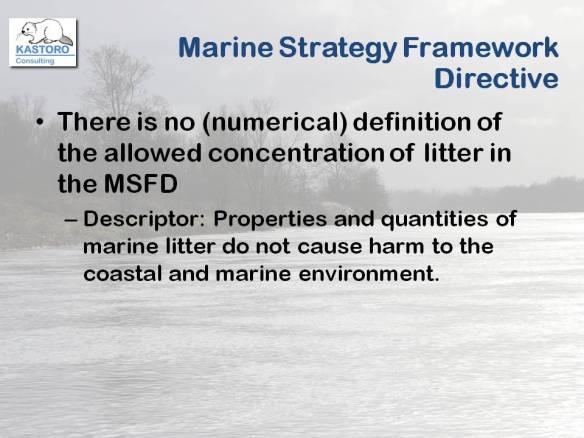
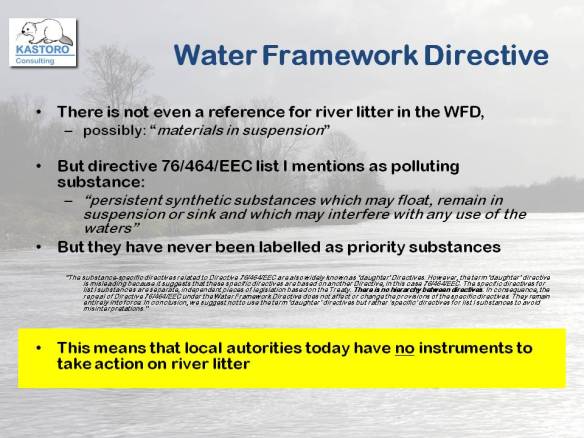
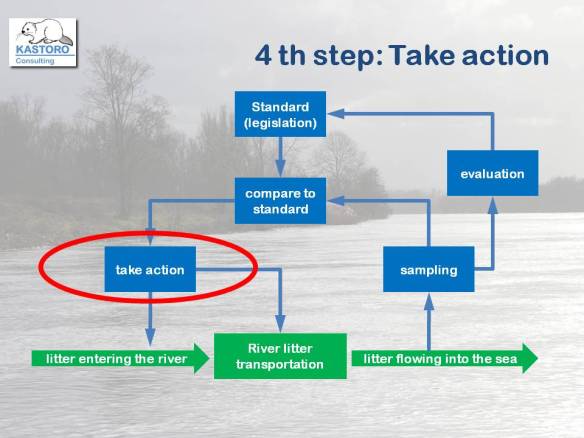
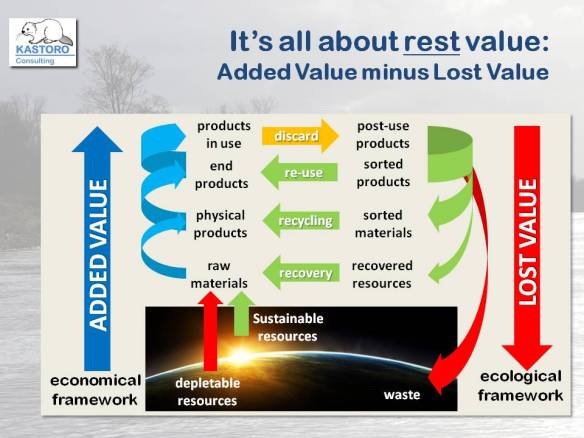
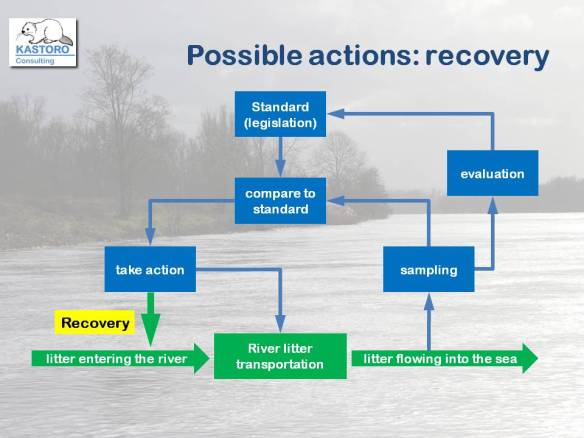
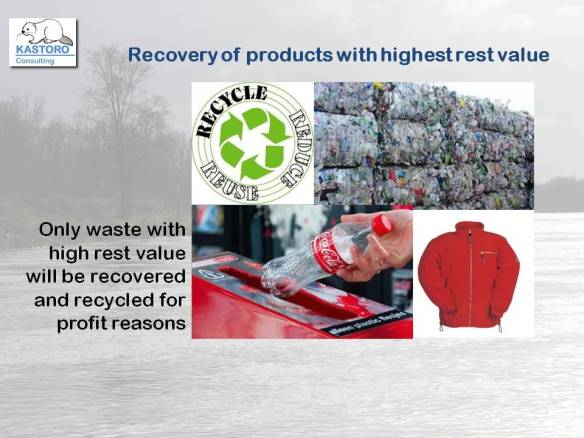
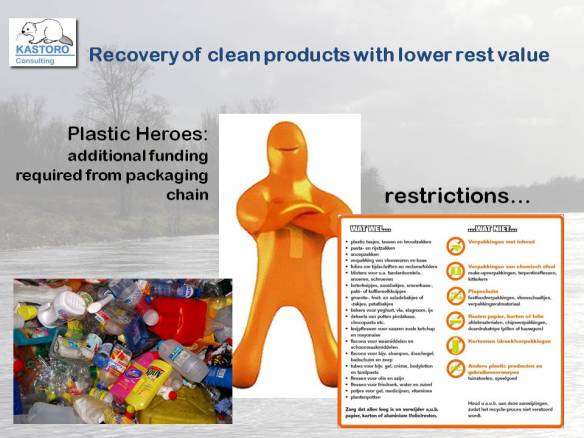
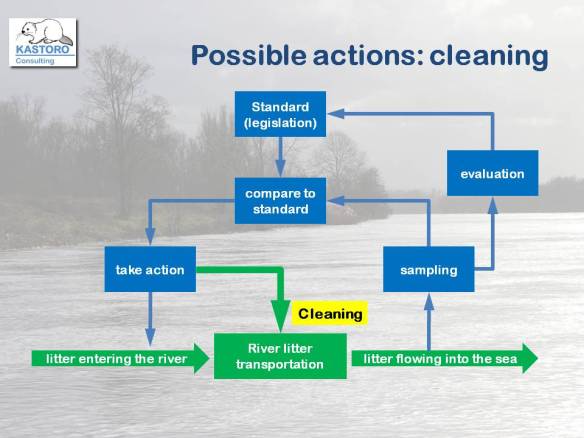
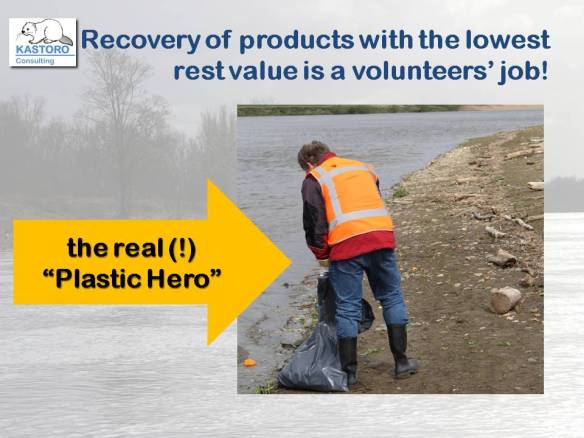
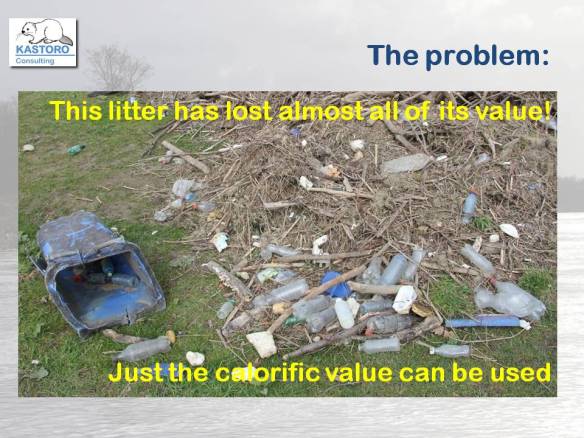
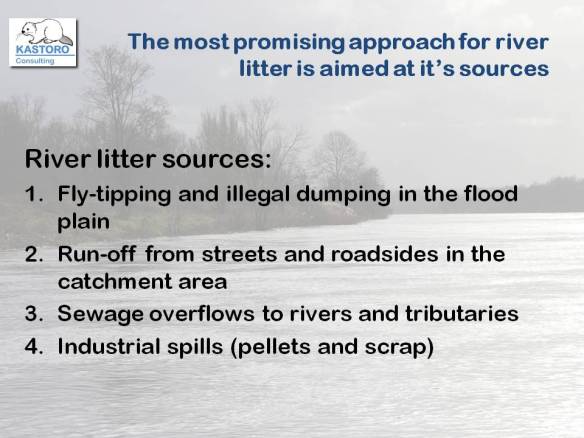
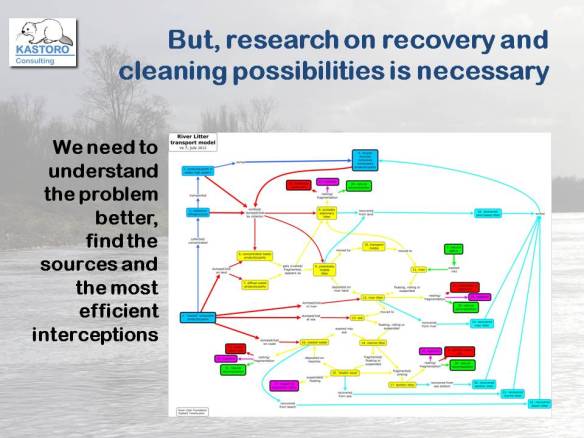
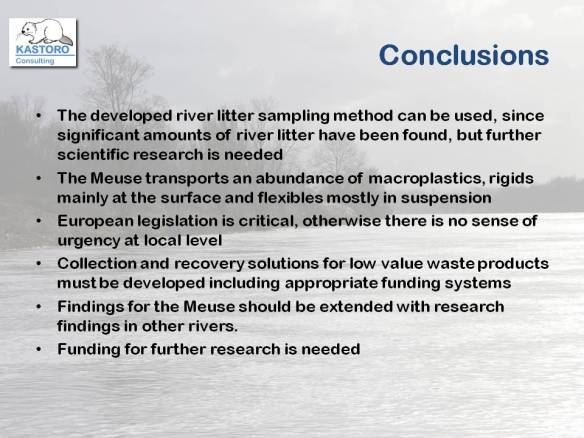
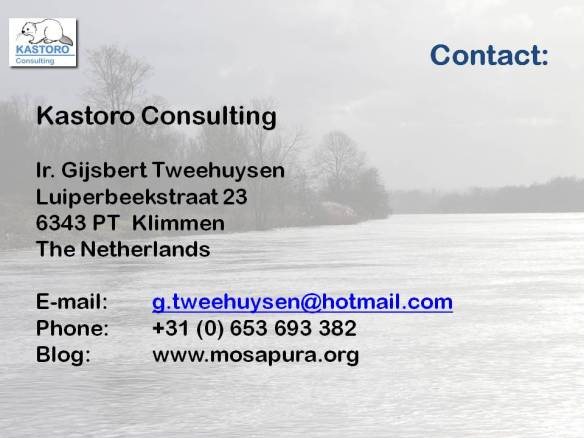
Plastic soup is “only” a part of the litter problem. Although this image is very appealing to the imagination, especially when also images are created from plastic islands somewhere in a far-away ocean, it makes you worry, but it hardly gives you clues to do something about it.
Actions like “BAN THE BAG”, or “RISE ABOVE PLASTICS” give some kind of psychological relief for all those people who want to do something, but you can be sceptical about the overall effect of these actions. Littering starts when people already have a product and leave it in the environment. So, these actions address “plastics” and not “litter”.
Sure, it brings awareness to the problem with the public and it urges politicians to put the issue on their agendas. That is true and so these actions are a good thing in itself. But for a solution we must do better!
The road from source to sink can be long and windy (see this video: The Majestic Plastic Bag). But it also shows clearly that there are numerous moments where it is possible to intercept litter reaching its final destination in the ocean.
I like to approach the problem from a technological more scientific point of view. Understanding the issues, bring logic and data in the discussion and act from an analysis of the situation. For that purpose I have drawn up a diagram of the flow of litter from source to sink.
The process starts (blue box on the middle-left) when someone owns a product, wants to get rid of it or loses it. When not discarded properly for reuse, recycling or whatever, litter starts a (sometimes) long way to a final destination.
(please click on the picture if you want a better resolution)
The blue arrows represent recovery and recycling processes, the red lines are emissions and the yellow arrows describe the flow of litter from source to sink when products or parts are released in the environment.
The red boxes represent the final destinations of litter on land, in the sediment of a river, on the bottom of the sea or on a remote beach. The purple boxes indicate the possibilities for ingestion by animals or organisms and the green boxes represent the decomposition (eg. composting of paper or rusting of metal ) as a natural process.
First of all you can see that there are a number of possibilities (red arrows) where waste can enter the environment. It can be thrown away on land, into a river, into the sea or left on a beach. Awareness and action campaigns can be directed at these emissions, technical solutions can be developed to prevent emissions like sewer overflows, organisational measures can be implemented to empty waste bins in time, etc.
The preferred route for disposal is the dark blue line upwards into some kind of a waste management system, although from there it should not leak back into the environment as an emission (birds picking from waste dumps or overflowing sewer systems). You can favour recycling, but from the perspective of preventing litter entering the oceans any recovery option is a good one (even incineration, when done properly).
You can also see the possibilities to recover litter from the environment (recover from land, riverbanks, beaches or recover litter from the bottom of the seas or from the sea-surface). It is a matter of economics, local circumstances and efficiency to choose for the best opportunity to intercept litter in one of these places. But anything recovered will not end up in one of the described sinks.
There are two circular movements in the picture. First the intermittent deposition of litter from the river onto the riverbank and the other from the seas onto the beaches. This immediately makes it clear how important constant beach-cleans and cleaning of river banks are in preventing litter to end up in one of the sinks. As long as litter is emitted in the environment, clean-ups are a vital ingredient of preventing litter from reaching the sinks.
Once litter has been transported by the river from land into the sea, the possibilities to capture it are drastically reduced. Only the very buoyant particles and products will remain somewhere near the sea surface and might get deposited on a beach by the wind or currents, the rest will disappear below the surface in the water column to end up for ever on the bottom of the sea or enter the food chain in some way. It is practically impossible to recover from there, although attempts are made (Fishing for Litter).
My conclusion from this diagram is that the river is the last practical place to intercept litter before it disappears in the vastness of the seas. It should be more easy to catch litter from a river than from an ocean, we should only be innovative to find ways to do that!
But, even if you have not risen above plastics, there is no excuse not to dispose your waste in the proper way!
While writing this blog I am watching the Giro d’Italia. While everything goes forward, every couple of seconds things go sideways: bidons. Below you see a picture of Tom Boonen getting rid of his drinking bottle (ok, not in the Giro….)
It makes sense that these guys do this with their bottles while racing, but recreational bikers do the same. What happens with these bottles? Here you see one that I found while letting my dog out.
A couple of cars must have been driving over it. Where is the cap? Ah, there is one in Meers,
Where is the rest of this bottle? My guess is that it is crushed in tiny fragments and washed away with the rain.
Here we may find a fragment of it…
But I think it is more realistic to look for its fragments right here!
You can picture the way these pieces have travelled:
Thrown away on a curbside or road, get crushed by cars, separating bottle from cap. Fragmented to a size that makes it easy for transportation by rain. Transported further by sewer systems, passing through purification plants, get transported by smaller creeks towards the Meuse. Get deposited for a while on the bank, but transported further after a high water period until flowing into the sea. Adding some more grammes to the plastic soup.
I follow a plastic bag already for a couple of months. This is how he looked while I first met him on January 1st 2012, being entangled in barbed wire.
A couple of months later this is how he looked:
Slowly disintegrating and showing the characteristic wrinkling of a weathered plastic film:
And where are the blown off pieces? Maybe here…
There is a general idea that plastics in the oceans get ever smaller through the impact of UV-light and wave-action. But I think the fragmentation is already far on it’s way when litter is still in a river.
So whenever we want to stop plastics flowing into the seas, we better be aware that we have to stop these little particles being transported. But that we can solve on land and we do not have to fish them out of the sea!
Maybe that is some good news
The effect of the surface to volume ratio demonstrated in the oceans. Same phenomenon as we have found in the river.
Based on observations and our first test runs, we can get some clues on how a river transports litter. Three basic elements must be considered:
The Meuse is a river that is completely determined by meteorological events in its catchment area. It starts in the north-east of France, flows through Belgium and the Netherlands.
It’s throughput is quite fluctuating through the seasons as the graph below shows:
This difference in throughputs implies that there is an intensive interaction with the river banks. Every peak leaves a mark on the bank, washed away whenever a higher peak follows. These lines on the picture below have been deposited during the peaks in the winter periods of the last couple of years.
At high throughputs the river is very turbulent. This turbulence pulls a lot of debris under the surface, only a small part of the debris stays afloat. Trees and bushes on the banks catch these suspended litter fragments, resulting in highly decorated trees after a period of high waters.
Rain and wind contribute to the transport of litter by a river. When it’s raining streets are washed clean, litter is transported through sewer systems and smaller rivers to the Meuse. Small litter passes through purification plants, where only big parts are collected.
Some installations catch the “first flush”, but most of the “clean” rainwater from the streets is directly discharged into a stream.
Wind creates small waves, picking up litter deposited on the banks, mixes it in the top water layer of the river, or pushes very buoyant parts onto another part of the riverbank. This intermittent way of transportation is very typical for the way a river transports litter.
With our first catches and a lot of searching along the riverbanks, we get a first glimpse of the kind of litter transported by the river. There are numerous divisions you can make, but one is most certainly related to the “surface to volume”-ratio. The larger this ratio, the more suspended a piece of litter will be, depending on the turbulence of the river.
A simple demonstration with plastic films with different thickness demonstrates shows clearly the impact of this “specific surface” aspect. The thinner the product is, the longer the product stays in suspension.
When the river is calm, like in summer with no wind, almost all floating (specific mass < 1) products will slowly drift to the surface. As soon as the wind starts to blow or the speeds and turbulence of the water increases, ever more litter will go in suspension at ever greater depths.
Litter with a high specific surface like leaves, packaging films, thin walled plastic products will disappear from the surface. It can be entangled in the flooded parts of the trees or just flow downstream towards the sea.
Litter with a low specific surface, like twigs, treestumps, PET and glass bottles, EPS foam and metal cans stay on the surface, even at the highest throughput rates. They get deposited on downwind banks or get concentrated in calm spots next to the current. Together with the films caught in the trees, they create the very visible litter fraction people get annoyed about in early spring.
Another characterisation is between big, small and very small. The next picture shows the results of a mechanical clean-up of the river bank. You can clearly see both the small and the big pieces, all very buoyant and therefore present on the river bank.
In this pile hardly any flexible plastics are found. The larger film pieces (like bags) hang in trees or might have entered the North Sea, together with all the other small pieces of flexible film products.
These are some of the first qualitative observations we have made. Now our job is to get a more quantitative and statistically valid approach towards all these phenomena we are discovering.
Interesting stuff for students!
The last couple of weeks we have been on the river every week testing our equipment. On Wednesdays we did our test runs looking for the methods to sample litter from the river. The thing we really wanted to find out was the mesh of the nets we should use in the winter season.
Basically we sample on two places:
a) skimming the surface with a surface net and
b) sampling the water at a depth of 10 – 60 cm with the suspension net.
So far we have been sampling with improvised nets made from do-it-yourself materials to get some clues about the mesh we should choose.
The surface net has a width of 1.35 m and the suspension net has an opening of 1,0 m x 0,5 m.
Test run 1 was done with only a suspension net with a mesh of 12,5 mm. After sampling more than 8000 m3, nothing was found.
That day was a beautiful day after a long period of dry weather. The throughput of the river was very low and there was no wind at all. All litter stayed peacefully on the banks or was trapped in bushes along the river. The water in the Meuse was or seemed “clean”.
One week later, test run 2 was done with both a surface net (mesh 6,25 mm) and the old suspension net with a mesh of 12.5 mm.The results were quite different from the results the week before. We caught quite a lot of litter on the surface net, not so much on the suspension net.
What was the difference with test run 1 the week before? First of all there was a lot of wind now and the water had sometimes waves of about 50 cm high.
Litter resting on the banks was washed in the river together with a lot of leaves and branches. We skimmed about 22.000 m2 and the result is shown here.
The suspension net (having a mesh of around 12 mm) showed results different from the week before.We caught mainly flexible pieces of plastics which were floating under the surface, pulled there by the turbulence of the wind-agitated water. Comparing the catch with the surface net was not possible because of the different mesh-sizes.
The third week we tried on both nets a mesh size of 2 mm, but here we had no success. The surface net collapsed by the pressure of the water and the suspension net was completely clogged with algae and silt.
We will now concentrate on building the final nets and prepare for measuring campaigns in winter where there will be water speeds of up to 15 km/hr. So far we have been measuring at maximum water speeds of only 1 or 2 km/hr!
Great fun!
The last couple of weeks we have been busy to test the equipment to measure the amount of litter in the Meuse. There are some elements worth mentioning:
The ship de Blauwe Reiger (The Blue Heron) is a 14.95 mtr long “barkas” build in 1952 in Germany as a service vessel for all kinds of jobs. The skipper (Twan) rescued her from a scrapyard and rebuilt her almost in her original state as a basic recreational vessel. The present owners (Yamila and Hergat) keep Twan using and servicing the boat and go out frequently together just for the pleasure of sailing on the Meuse.
When they heard of our interest in using the Blauwe Reiger for measuring purposes, they immediately agreed to cooperate and they are ever more enthusiastic about the purpose of this whole venture. No other boat owner would allow us to drill holes in the hull or install masts and gear on their ships, but they do… and we cannot be grateful enough for their cooperation!
The catamaran shaped pontoon, carrying the net between the floatation bodies was designed to be towed alongside the boat to prevent measuring in disturbed water from the propellor. As the tests showed, the floatation bodies and the shape they have, just leave the water flowing between them almost undisturbed and the net can cleanly cut through a surface of 1m x 0.5 m water. After the first test this was not yet perfect, but after modification it worked out beautifully. The net operates at a depth of approx. 10 cm. and catches the materials which are in suspension. As a hypothesis we assume this 10 – 60 cm depth will be representative for the rest of the water column, especially in turbulent conditions, but this has to be proven.
The pontoon can be equipped with a net skimming the surface to catch the materials that really float on the surface like bottles, branches and other products with a low specific surface (surface/volume ratio).
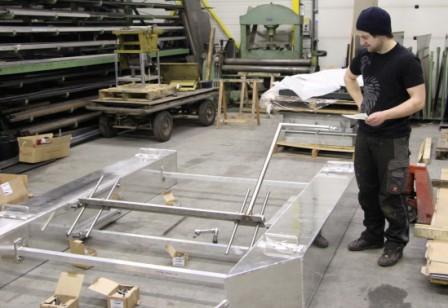
The rigging needed to tow the net next to the ship (picture)
The current speed sensor with the mounting took also some attention. Normally this sensor is used to be mounted in more spacious environments with less chance to get covered with litter or in deeper water. It took some tests to get rid of the vibrations that started to occur in the first runs. We have clear readings now that give us accurate information of the watervelocity we have when towing the net through the water. It allows us to calculate with great accuracy the volume of water we have sampled.
The nets gave us quite some headache. The supplier had send us the nets THREE TIMES !!! and they kept getting lost in the logistic mess of the parcel delivery guys. Okay, we did the testruns with a improvised net I build in my backyard under the watchfull eye of my dog and we learned what we needed to learn.
The improvised net has a mesh of 24 mm. The real nets will be 18 mm and 1,1 mm. These should give us the information we are looking for.
The basic procedure of the test is as follows:
surface (m2) x velocity (m/s) x duration (s) = volume of sampled water.
Checking the caught litter and categorise it with the OSPAR list, will give us the concentration of litter per cubic meter of river water. This is what we want to know as a first objective.
Further analyses of the data and the samples will give us information on the materials, the sources, and the position in the river where the samples are collected.
Every Wednesday we will be on the Meuse for measuring. Feel free to contact me if you want to join us (call +31 6 53693382 or reply to this blog)